Photo
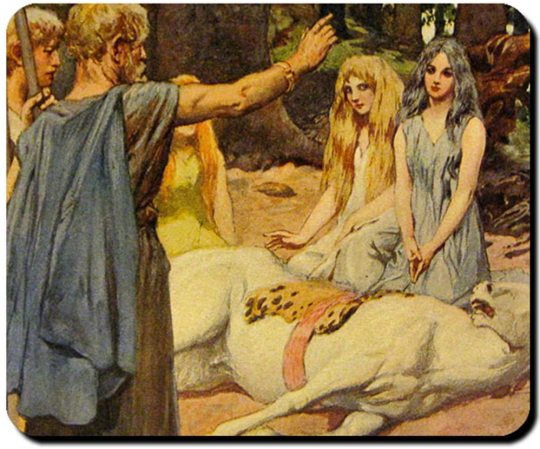
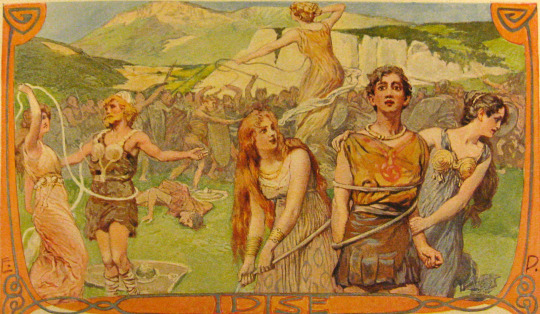
Sinthgunt
Sinthgunt is an almost completely unknown deity whose name has been mentioned in the Merseburg charms. She has been described as being the sister of the sun Goddess Sol and both participate in a healing ritual. There are no other known sources that mentions Sinthgunt so a lot of questions remain unanswered. Who was Sinthgunt exactly? What is her role in the Germanic pantheon? What is her relationship to her sister the sun?
"Phol and Wodan were riding to the woods,
and the foot of Balder's foal was sprained
So Sinthgunt, Sunna's sister, conjured it
and Frija, Volla's sister, conjured it
and Wodan conjured it, as well he could"
- Merseburg charm
Even the meaning of her name is unknown but certain theories exist. One theory suggests that she is the exact opposite of her sister, thus representing either darkness or the moon. This theory claims that her name stems from the Germanic 'Sin, Nax, Gund' which means 'the night-walking one'. Although this is a theory that makes some sense, it is an unlikely one. The moon in the Germanic culture is a masculine force and therefore not represented by a sister of the sun.
Another theory suggests that the name Sinthgunt comes from the Proto-Germanic 'Senþa-gunþjō' which translates into 'raid-fight'. This etymology fits if you look at related old High-German female names such as Sindhilt. Yet another theory suggests that Sinthgunt refers to a 'heavenly body', a star perhaps. This last theory fits the Merseburg charm nicely as well since the sun is also a star and her sister might be a star as well. There is however no good evidence to back this theory up and the ancient Germanic people probably weren't aware that stars are also suns.
Since there is so much uncertainty about the meaning of her name, we can not get any clues from her name on her role in the Germanic pantheon. Friedrich Kauffman, a philologist, researched Sinthgunt in the 19th century and determined that she was not a Goddess but in fact a valkyrie. Friedrich based this theory on the fact that elements of Sinthgund's name are also known amongst other valkyries.
Another theory tells that Sinthgunt is not a deity but an aspect of Sol, the sun Goddess. This theory is based on the mentioning of Fulla and Frigg, Fulla also appears to be an aspect of Frigg. A similar theory suggests that Sinthgunt might be a minor Goddess, a servant of Sol. Yet again none of these theories can be proven but it is still interesting observing these possible explanations.
Karl Heim rejected the Valkyrie theory and instead grouped Sinthgunt together with the Idisi, a divine female being. The Idisi are in fact mentioned in the Merseburg charms and in the epic English poem Beowulf.
"Once the Idisi sat, sat here and there,
some bound fetters, some hampered the army,
some untied fetters:
Escape from the fetters, flee from the enemies."
- Merseburg charm
It's quite amazing that so many theories exist about this unknown Goddess since her name has only been mentioned once in all of recorded history. Sadly we will never know what her exact role in the Germanic pantheon is. She might be a sister Goddess, a valkyrie, a minor Goddess, an aspect of Sol/Sunna or part of the Idisi. Perhaps future archeological finds can provide us with some more clarity.
Here are two images representing the healing and the idisi by Emil Doepler,
184 notes
·
View notes
Photo

Meda
Meda might be one of the most unknown Germanic deities. She is a Frisian Goddess whose name can be found in the modern day West-Frisian city, Medemblik. Very little is known about this deity but there are still some surviving stories in West-Frisia about her function in the Germanic pantheon and a written document that mentions her full name.
The written document dates back to the year 985AD and mentions the older name of the city Medemblik, this older name appears to have been the full name of the Goddess, Medemelacha. Her full name means 'virgin of the leek water'. She appears to be a local river Goddess which is not a strange thing because every river was connected to a deity.
There is a local legend in West-Frisia that speaks of the origin of the city Medemblik and a possible temple in built in honour of Meda. A Frisian lord named Diederik (related to the later lords of Holland) is supposed to have settled himself in modern day West-Frisia around the year 300AD, this would be around the same time that the original Frisii slowly started to disappear.
Lord Diederik founded the city of Medemblik in honour of the Goddess Meda according to the legend. Inside this new settlement he also built a temple dedicated to Meda which was quite famous in the surrounding area, drawing many visitors who all wanted to see the beautiful temple. A statue of Meda was located inside this temple, some claimed it was made of pure gold. The legend also claims that sometimes young men were sacrificed in honour of this Goddess.
Is there a core of truth behind this legend? We do know that there used to a small river that flowed through West-Frisia which is called the 'kromme Leek'. This river might very well be the river connected to the Goddess Meda as her full name refers to a river of the same name. The river flowed through West-Frisia as early as 2,500 years ago but because of peat extraction during the medieval ages, the river slowly lost ground. Some parts of the river still exists until this very day.
We can of course not verify the story of Diederik founding the city of Medemblik in honour of the Goddess Meda but it is very likely that she seems to be a local deity connected to the river 'kromme leek' in West-Frisia, the river ends in Wervershoof, a small village right next to Medemblik. The origin of her worship might actually be much older than the Germanic culture, assigning spirits to natural objects like rivers is part of the oldest belief in the world, animism. Perhaps she has already been worshiped since the mesolithic era (maybe even earlier) but the spirit was given a name and identity during the iron age.
Here is an image of the kromme Leek river.
63 notes
·
View notes
Photo
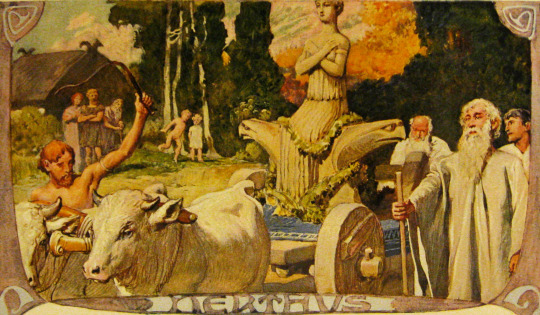


Nerthus
Nerthus is the Germanic Goddess of fertility and also sometimes called 'mother earth'. She was in fact a very important deity and one of the very few ancient Germanic deities of which we have an account of a ritual written by Tacitus and backed up with archeological finds. It is thought that Nerthus is one of the earliest deities in the Germanic pantheon, older than the concept of the Asir and the Vanir.
Nerthus' name is still in its Proto-Germanic form, with the exception of the last letter, 'Nerþuz'. Her name means: 'strong, healthy or powerful'. The name has barely changed except for in Scandinavia where she underwent a very interesting evolution. Sometimes Nerthus is also refered to as Hertha, the origin of that name is unclear but most historians believe that this was simply because of a translation mistake. If you would translate the Proto-Germanic word 'Nerþuz' into old Norse, you would get the word 'Njord'. Interestingly, the Norse deity Njordr has similar attributes compared to Nerthus and it is therefore generally agreed that Nerthus turned into Njord in Scandinavia, basically Njordr is a later, male, depiction of the ancient Goddess Nerthus.
The true nature and appearance of this deity is not fully known. We know she is a Goddess of fertility but that's about it. We do not know her role in the ancient Germanic pantheon although there are theories. Judging by descriptions made by Tacitus and archeological evidence, the chariot was an important attribute. The chariot isn't exactly a classic Germanic object but ìt was used by the Proto-Germanics during the bronze age, this suggests that the worship of this deity might have started during the Nordic bronze age, together with the worship of several other elder deities such as Ull, Wodan, Frey, Tiwaz, Freya and Sol, together they are the earliest Germanic deities whose worship started during the bronze age.
Thanks to Tacitus we know of a religious rite directly related to Nerthus, it is one of the very rare glimpses into the ancient Germanic spirituality that involves the worship of a deity and human sacrifice. According to Tacitus, Nerthus was mainly worshiped by 7 tribes that belonged to the Suebi confederation: the Reudingi, Aviones, Anglii, Varini, Eudoses, Saurini and Nuitones. Here is the full text of Tacitus in his work Germania on Nerthus:
"The neighboring Reudigni, the Avions, Angli, Varini, Eudoses, Suardones, and Nuithones, are defended by rivers or forests. There is nothing noteworthy about these peoples individually, but they are distinguished by a common worship of Nerthus, or Mother Earth. They believe that she interests herself in human affairs and rides among their peoples.
In an island of the Ocean stands a sacred grove, and in the grove a consecrated cart, draped with cloth, which none but the priest may touch. The priest perceives the presence of the goddess in this holy of holies and attends her, in deepest reverence, as her cart is drawn by heifers.
Then follow days of rejoicing and merry-making in every place that she designs to visit and be entertained. No one goes to war, no one takes up arms, every object of iron is locked away, then, and only then, are peace and quiet known and loved, until the priest again restores the goddess, satiated with mortal intercourse, to her temple.
After that the cart, the cloth and, if you care to believe it, the goddess herself are washed in clean in a secluded lake. This service is performed by slaves who are immediately afterwards drowned in the lake. Thus mystery begets terror and pious reluctance to ask what the sight can be that only those doomed to die may see." - Tacitus, Germania
According to Tacitus, a special rite was conducted on an island which involved days of celebration and a peace amongst the Germanic tribes involved in this festival. An image of Her was concealed in a cart, covered with a cloth. Only priests were apparently allowed to touch this cart or the image of her. This cart would be driven around the land until eventually it was placed back inside the grove. The unfortunate souls who helped with this proces, the slaves mentioned by Tacitus, were immediately put to death after the ritual, to make sure that only the priests had knowledge of her cart and image.
Is there any archeological evidence to back this ancient sacred ritual up? There are actually several candidates for the location described by Tacitus. The most convincing theory is that this grove of Nerthus was located on the island of Zealand in Denmark based on the fact that the old medieval name of a place on this island is linked with the word Nerthus, Niartharum.
Several archeological discoveries have been made of ritual wagons from Denmark that date back to the Bronze age. We know that these wagons were for ceremonial purposes because they were incapable of making turns, that would make for a horrible wagon if used in daily life. These ceremonial wagons could perhaps have been used in the ritual described by Tacius.
Another theory, that has now been debunked, suggested that the grove of Nerthus was located Rügen, a German island. This theory is based on the interpretation of the name Hertha but now that we know that Hertha was a translation mistake, this theory has been debunked and Rügen is no longer considered as the potential site.
There is yet another theory that suggests that the grove of Nerthus could have been located near the modern city of Haarlem in the Netherlands. Two men during the 19th century made a comment on a temple located in the dunes that was dedicated to mother earth, here is one of the two short descriptions:
"And as we still find the flowers of the old forest in our woods, so we see among the Haarlem people, in their joyful journeys to Kraantjelek and in the celebration of Hartjesdag, the traces of the former worship of the Earth, Hertha, our great and good mother." - Frederik Willem van Eden, 1867
A Dutch writer of history, Jan Ter Gouw, claimed that even the name of the city Haarlem is linked with the deity. We can however debunk this theory since we know that Haarlem comes from the Dutch words 'Harula' and 'heem' combined which translates into 'settlement on a sand ridge'. There is also no archeological evidence of an ancient pagan temple in Kraantje Lek so these two theories seems have been based on 19th century romanticism, part of the revival of the Germanic mythology.
Another, more possible, theory is that the grove of Nerthus was located on Helgoland, an island now part of Germany. This theory is fully based on the description of Tacitus and the appearance of the island. There is however no archeological evidence to back up this theory so until we find actual archeological evidence in the form of ancient carts or statues, the Danish Zealand seems to have been the most likely location of this ritual.
Nerthus continues to be a truly fascinating deity linked to one of the very rare written accounts of a Germanic religious ritual. Even though she was celebrated during a festival of peace, humans were sacrificed at the end of the rite. She's one of the oldest deities in the Germanic pantheon and can rightly be called mother of the earth, perhaps she is the mother of us all.
Here are images of:
Nerthus by Emil Doepler,
Ceremonial Wagons from Dejberg located in Denmark,
The Trundholm sun chariot,
118 notes
·
View notes
Photo

Lex Frisionum
The lex Frisionum, law of the Frisians, is a code of law of the Frisians which was written down in Latin during the reign of Charlemagne. Even though Frisia was conquered by the Franks at this point, many of these laws predate Christianity and gives us an unique insight into the justice system of the ancient Germanic people.
The laws recorded in this code shows us what the punishments were for theft, murder, pyromancy, desecrating pagan temples and other crimes. The punishment was often a payment, 'weergeld', the height of the payment depended on the nature of the crime and your social status. Here are a few of the punishments described in the Lex Frisionum:
On manslaughter:
- If a noble man kills a noble man, he pays 80 solidi of this compensation, two parts belong to the heirs of the victim, and a third to his next of kin.
(the payment for killing a freeman is 53 solidi and 1 denarius, 27 solidi for killing a serf)
-If a freeman kills a noble man, he pays 80 solidi or if he denies he swears with 17.
-If a serf kills a noble man, he pays also 80 solidi; or if he denies, he excuses himself with thirty-five oath-helpers of his own rank.
-If any man, be it a noble man or freeman or serf or even slave, kills the slave of another, he pays according to how it is valued, and the lord swears with his oath that this was the right price.
On theft:
-If a noble man is accused of some theft and he wants to deny, than he swears with five oath-helpers.
-Or, if he can not deny, he returns what he took twofold and he pays to the king 80 solidi as peace money, being his wergeld.
-If a freeman is being accused of theft and he wants to deny, he swears six fold with freemen; or if he confesses he repays what he took twofold and he pays to the king as peace money his wergeld.
-If a slave is being accused of being guilty of theft, his lord will swear the oath for him on his garment.
-Or, if it was something of great value, the lord swears on the relics or the slave is tested with an ordeal in boiling water.
-If someone is caught stealing, and is being accused of theft by the one who caught him, and he denies, than each of them swears alone, and they must be judged in an ordeal with boiling water if the guilt of the accused is proven, he pays his wergeld to the king and redeems his hand with 60 solidi and pays the single fine for theft.
On pyromancy:
-If someone sets fire to the house of another, he pays him his house, and everything in it that was burnt, twofold.
-If, however, by the flames he forces the lord of the house to come out and then he kills him, he pays nine fold for him, whatever his rank was, whether it be noble or free or serf. This regulation has been issued by the king.
On whoring:
-If a woman has united herself lecherously with a man, she pays to the king her wergeld this must be done by a noble man and a free woman.
-But if it was a slave and a virgin, on which the man laid his hands, than he who violated her pays to her lord 4 solidi, that is 12 denarii.
On killing relatives:
-If someone kills his father, he looses the heritage that would be his due.
-If someone kills his brother, he pays for him to his closest heirs if he had a son or daughter, or, if he did not, he pays his father or his mother or his brother or also his sister; if there is none of these persons, he pays for him to the king.
On wounds:
-If anyone hits another on the head in anger, and thus makes him deaf, he pays 24 solidi.
-If the bone is broken, he pays 12 solidi.
-If anyone chops off another's ear, he pays 12 solidi.
-If anyone pierces another's chest, he pays 12 solidi.
-If anyone cuts off another man's penis, he pays the victim's wergeld.
-If anyone grabs another by the hair in anger, he pays 2 solidi, and as peace money 4 solidi to the king.
-If anyone pushes another who is standing by the water and throws him into the water, and he submerges, he pays 4 solidi, and as peace money 2 solidi.
-If anyone touches the breasts of a free woman, who is not his own, he pays twice 4 solidi and 2 solidi as peace money.
-If anyone rescues a man who by some coincidence had fallen into the water, he receives a reward of 4 solidi.
On the honour of the temple:
-If anyone breaks into a shrine and steals sacred items from there, he shall be taken to the sea, and on the sand, which will be covered by the flood, his ears will be cleft, and he will be castrated and sacrified to the god, whose temple he dishonoured.
The last law that I have mentioned is perhaps the most interesting one of them all since it is the only Germanic pagan religious law that we have. Surely Charlemagne wouldn't want to publish a code of law with so many pagan elements, it is therefore thought that the Lex Frisionum was an early draft of the Frisian law, an early draft based on much older pagan laws.
92 notes
·
View notes
Photo
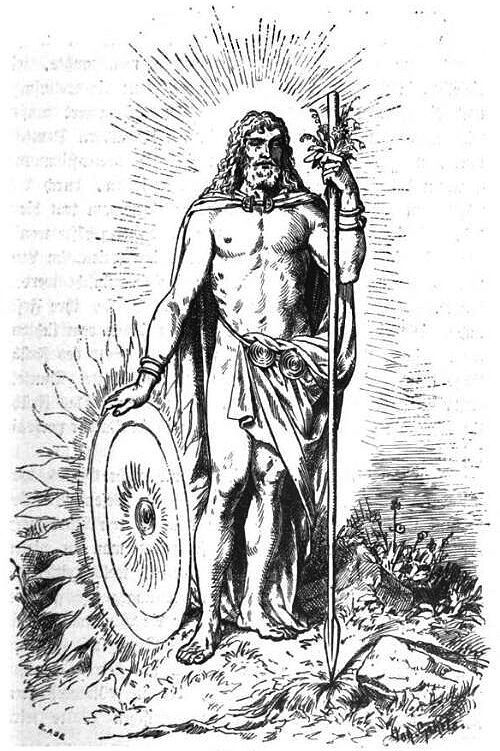



Baldr
Baldr is a Germanic deity perhaps best known for his death described in the eddas. It seems as if Baldr is purely a Norse deity but there are possible written down records that mention his name outside of Scandinavia. Unfortunately too little is known about this deity before the medieval ages so these records are just part of possible theories.
Baldr is seen as the deity of light, summer and joy. He is the son of Odin according to old Norse sources and owns a ship called the Ringhorn. He is basically the personification of everything good and pure. His mother Frigg, worried about his life after having bad dreams about her son, makes an oath so that not a single object can harm him. Unfortunately for Frigg, she forgot to add mistletoe to the list of objects and Loki eventually exploited this weakness which led to the death of this much beloved God. Baldr's death kickstarts a chain of events that eventually leads to Ragnarok. These events have been written down in the medieval ages but is there any evidence that Baldr was known amongst the ancient Germanic people?
Let's start by looking at his name. Baldr is an old Norse name which could have been derived from the Proto-Germanic word 'balþaz' which means 'brave'. There is a theory that the word 'brave' is named after the deity but this is highly uncertain. Another theory suggests that the name came from the Proto-indo European word 'bhel' which means 'white'. This makes sense as Baldr is often descripted as being pure, bright, fair or shining.
The most convincing piece of evidence that Baldr was known outside of Scandinavia comes from the Merseburg charms. These are two incantations written down in old High German that date back to the 9th century. The second Merseburg charm describes how Wodan healed a horse, this incantation was probably used by people trying to heal their injured horse, and mentions the name Balder:
"Phol and Wodan were riding to the woods,
and the foot of Balder's foal was sprained
So Sinthgunt, Sunna's sister, conjured it
and Frija, Volla's sister, conjured it
and Wodan conjured it, as well he could
Like bone-sprain, so blood-sprain,
so joint-sprain:
Bone to bone, blood to blood,
joints to joints, so may they be glued." - second Merseburg charm
Another source that mentions Baldr's name is the Gesta Danorum, a 'history on Denmark' written by Saxo Grammaticus somewhere during the 12th century. Interestingly enough, Baldr suffers a slightly different fate even though the story has similarities to the ones told in the eddas. In the Gesta Danorum, Baldr is not a God but a demi-God who is at war with his rival, king Hother, for the love of a woman named Nanna (Nanna is also the name for Baldr's wife in the eddas)
The rivalry between the king and Baldr grew until one day they decide to fight each other on the battlefield. Baldr appears to gain the upper hand in the battle until Hother wields a sword conveniently named mistletoe. Baldr gets defeated and dies a short time later. It was Loki who encountered Baldr and made him possessed about the woman which eventually led to his death. This source is quite interesting but it is unknown if Saxo based this story on the eddas or if this is really an alternative tale on Baldr.
The oldest possible source on the worship of Baldr outside of Scandinavia comes from the Netherlands. An inscription has been found in the city of Utrecht which dates back to either the 3rd or 4th century AD and is written in Latin. The name 'Baldruo' is mentioned in this inscription but it is not certain at all if this name refers to the deity. We can't however fully exclude this source so that is why I found it worth mentioning.
There is however also a theory that excludes Baldr from the Germanic pantheon. The earliest written mentions of his name are uncertain so this makes some historians believe that Baldr wasn't even a Germanic deity at all. Baldr could perhaps just refer to a title of Wodan or was added in by Christians since Baldr has many similarities with Jesus of Nazareth, both are described as being pure, white and good and both died in a tragic way. The eddas were after all written down by a Christian, the Gesta Danorum as well.
Not a single depiction of Baldr exists before the medieval ages either, nor are there any sources about his worship or any possible temples. This makes the theory that Baldr is basically the Norse version of Jesus more likely. Also the fact that Baldr's death leads to Ragnarok is incredibly Christian in nature as ragnarok is quite similar to the Christian end-of-times described in the book of Revelation. Also Loki is often compared to the Christian devil, the one responsible for Baldr's death. Loki's existence is very doubtful, not a single archeological proof has been found that confirms Loki's existence in the Germanic pantheon. Perhaps Loki and Baldr are just Norse versions of Jesus and the devil.
Here are images of:
Depiction of Baldr by Johannes Gehrts,
Baldr's fight with king Hother by Johannes Wiedewelt,
Baldr's death by Christoffer Wilhelm Eckersberg,
Page containing the Merseburg charms,
90 notes
·
View notes
Photo
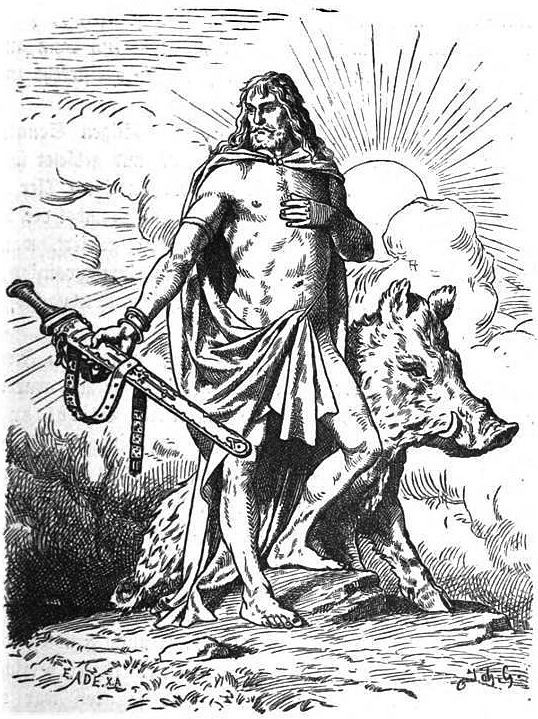

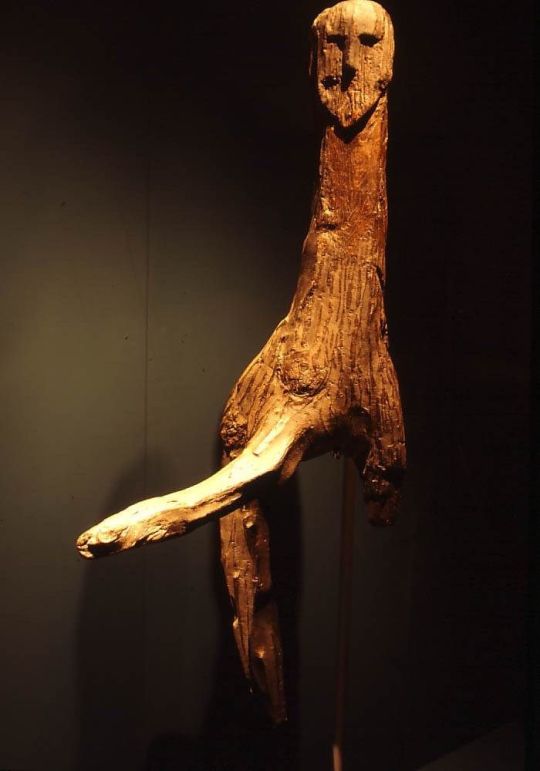


Frey
Frey is the Germanic God of harvest, peace and fertility. He's the twin brother of Freya and possibly the most loved God of all the Germanic deities, which makes sense considering that the harvest and fertility were one the most important aspects of Germanic life in peace time. Judging by his character and attributes, he could also be one of the oldest Germanic deities.
Frey is being described as part of the Vanir tribe. He owns a ship, Skidbladnir, which has the ability of being able to fold up so that it could be carried inside a pocket. He is often depicted with his boar, Gullinbursti, who has a golden mane and can run faster through air and water than any horse. Further more he is often depicted with a huge phallus, which symbolizes his fertility, and a sword.
The meaning of his name is incredibly similar to his twin sister's name. Both Frey and Freya are titles rather than personal names. As I have explained in an earlier post, Freya means 'lady', the same seems to be true for Frey. Frey literally means 'lord', the word is derived from the Proto-Germanic 'Frawan' which means lord. The actual true name of Frey is therefore uncertain but we have a very likely theory.
Several archeological finds, written sources, still existing traditions and place names have been discovered that have a link to this deity. There is also a theory that might explain Frey's actual name. Yngvi is the name often linked to Frey and might actually be a much older name to describe this deity than Frey is. But why? Frey is a name, or rather a title, that seemed to have been used in the early medieval ages, especially during the viking age. The name Yngvi however has been mentioned by Tacitus back in 98AD.
Tacitus described a region which belonged to the Ingvaeonic people, Ingvaeones can be translated into 'son of Yngvi'. The Ingvaonic people are said to have been descended from Yngvi who in turn was a son of Mannus, Mannus himself was a son of Tuisto, better known as Tyr the oldest deity of the Germanic pantheon and former chief God. This theory might actually be the only, pre-viking, attempt in making a family tree of the Germanic Gods. It gives us an interesting insight in the ancestral tree of the Gods before the medieval ages. The modern day Ingvaeonic offspring are: the Dutch, North-west Germans and the Danish people.
Another source linking the name Yngvi with Frey comes from the Ynglinga saga written by Snorri Sturluson. In this tale, that tries to legitimize the reign of old Norse kings by linking them to Frey, Frey is being mentioned as Yngvi-Frey. If Yngvi is really the true name of Frey, that means the Inguz rune is bound to him. There are also many modern day names in the Swedish, Danish, Dutch, Frisian, old English, Norse and Incelandic language that are linked to Yngvi, per example 'Inge' and 'Ingrid'.
The old English Runic poem, written somewhere during either the 8th or 9th century, contains a stanza about Inguz which seems to confirm the link between Yngvi and Frey:
"Ing wæs ærest mid Eástdenum
gesewen secgum, oð he síððan eást
ofer wæg gewát. wæn æfter ran.
þus Heardingas þone hæle nemdon."
"Ing was first among the East Danes
so seen, until he went east
over the sea. His car followed.
Thus the Haerdingen called that hero."
Here he is also described as 'first of the Danes' just like Tacitus had done many centuries before this poem was written down.
Most of our written and archeological sources however come from medieval Scandinavia. Adam of Bremen, a German chronicler from the 11th century, has written down several Scandinavian pagan practices and mentioned the God Frey with his Latinized name 'Fricco':
"In this temple, entirely decked out in gold, the people worship the statues of three gods in such wise that the mightiest of them, Thor, occupies a throne in the middle of the chamber, Woden and Fricco have places on either side. The significance of these gods is as follows: Thor, they say, presides over the air, which governs the thunder and lightning, the winds and rains, fair weather and crops. The other, Woden that is, the Furious—carries on war and imparts to man strength against his enemies. The third is Fricco, who bestows peace and pleasure on mortals. His likeness, too, they fashion with an immense phallus."
- Adam of Bremen, Gesta Hammaburgensis
A statue of Frey has also been found in Södermanland, Sweden in 1904. This statue has been dated back to around the year 1000 and is made entirely out of bronze. The statue is about 7 centimeters tall and depicts Frey with a beard, hat and an erect penis. Interestingly enough, ancient wooden statues have been found inside bogs, in both Denmark and the Netherlands, that depict a figure with an erect penis. These statues date back to the bronze age and might perhaps be the earliest representations of Frey.
Unfortunately we do not exactly know how the ancient Germanic people worshiped Frey. There are several theories based on present day traditions and historical research, by comparing Frey with other fertility deities. One of these theories, based on the fact that Frey is almost always depicted with an erect penis, is that Frey might been linked to certain unknown sex rites. It is of course completely unknown what these rites would have been like, perhaps by singing? Adam of Bremen mentioned in his work that certain raunchy songs were sung in temples.
Another theory, which might date back to the Proto-indo European culture, is that the people might have honoured or sacrificed a horse's phallus. Another, perhaps the most wildest theory, concerns the description made by Ibn Fadlan, a 10th century muslim traveler who witnessed a bizare ritual surrounding a burial. According to his words, a slave girl that was sacrificed, was first put through several sexual rites, it is unknown if it was basically a rape or part of an ancient ritual, perhaps a ritual based on the worship of Frey.
There is still at least one existing tradition that can possibly be linked to Frey. This tradition, which I have practiced myself as well, is practiced in the Netherlands right after harvest. According to the tradition, the last piece of harvest is left behind on the field and made into a doll figure to thank Frey for the succesful harvest and blessing the land for next year's harvest.
Frey certainly is a fascinating deity and we still have much to learn about him and the history behind the people who worshiped him.
Here are images of:
Frey by Johannes Gehrts,
Swedish Frey statue,
Danish bog statue of a possible ancient depiction of Frey,
A map showing the Ingvaeonic people in red,
A Dutch harvest doll,
189 notes
·
View notes
Photo



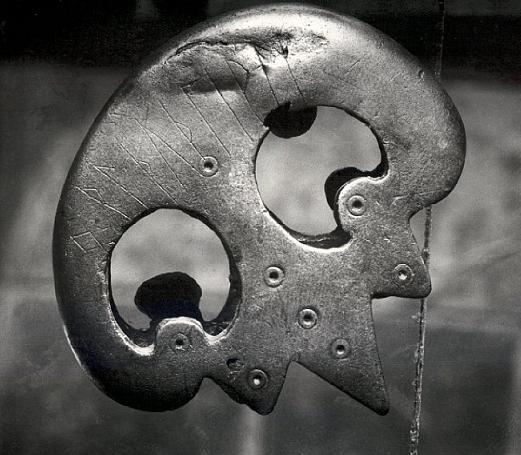
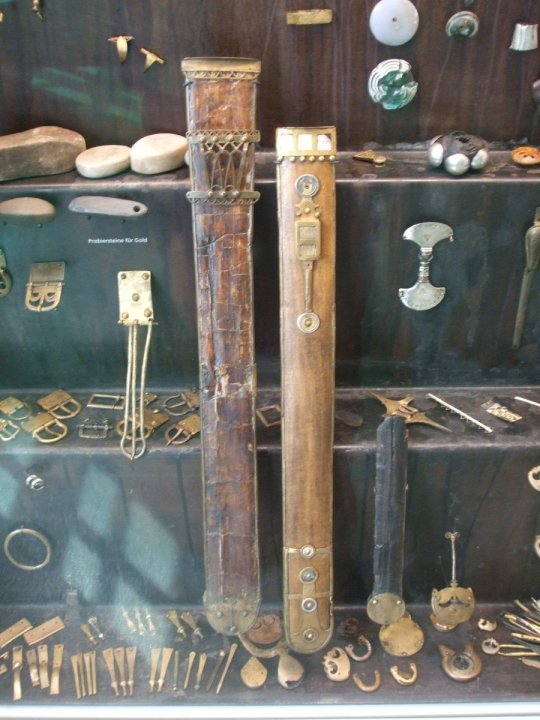
Thorsberg Moor finds
The Thorsberg Moor is located in the German state Schleswig-Holstein, the northern most state of modern day Germany. This bog has apparently been used by the ancient Germanic people as a place of sacrifice as archeological research has uncovered stunning items which are well preserved thanks to the bog.
It was Helvig Conrad Engelhardt who started excavating the bog during the 19th century. Helvig had started his research because peat cutters found strange items in the bog. The excavations took three years, from 1858 until 1861. During those three years, hundreds of items were discovered which all date back to an era between 100BC-450AD.
What I find most interesting about these bog discoveries are the nature of the finds. The oldest items, dating back to around 100BC, seem to have been offered to bless the land with fertility. The more recent items, dating back to around 200AD, are much more military in nature. Whether this has to do with a changing lifestyle or an ongoing war is uncertain.
The most rare finds are the pieces of clothing that have survived almost completely intact until this very day. It is always difficult to determine what kind of clothing ancient people wore because clothing deteriorates very quickly. However, a completely intact Germanic tunic and trousers have been found in the bog which gives us great insight in what kind of clothing the Germanic people wore.
Beside the clothing, several artifacts have been found, such as the chape with a runic inscription dating back to around 200AD, the object I mentioned in my previous post. Multiple weapons, all been broken on purpose before deposited, military decorations, fibulae, shield bosses, jewelry and even some Roman military equipment.
Despite the bog being named 'Thorsberg Moor', it is not certain at all if all of these items were offered to Thor. If you are interested in viewing this objects personally, then you should definitely consider making a trip towards Gottorf castle or the national museum of Denmark in Copenhagen.
Here are images of:
Present day landscape of the Thorsberg Moor,
Germanic tunic and trousers,
The chape I mentioned in my previous post,
Thorsberg shields,
Other items found in the bog,
80 notes
·
View notes
Photo

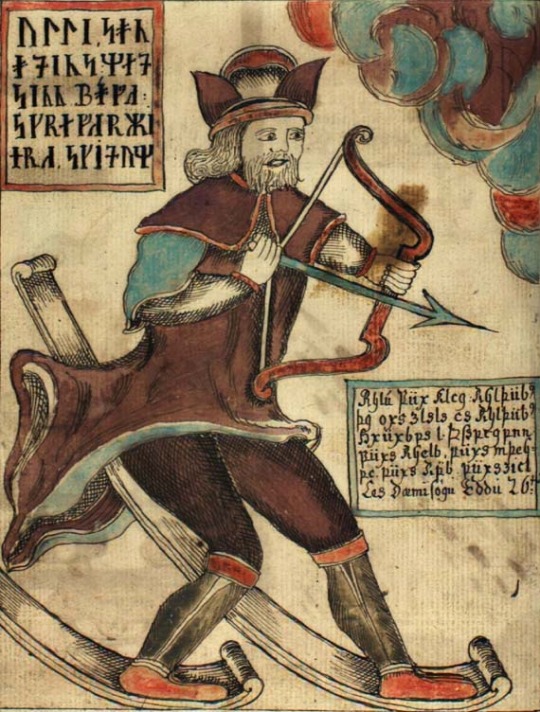
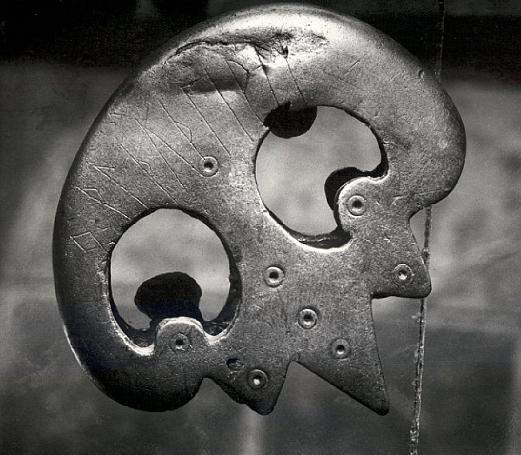
Ullr
Ullr is a Germanic deity who has been mentioned in the eddas like the Grimnismal and Gylfaginning. He is a God of the hunt, archery and winter. Despite the fact that the name and most of the written sources are from medieval Scandinavian sources, he actually played a more important role in the history of Germanic spirituality. Ullr was not just known in Scandinavia, the ancient continental Germanics knew him as well.
The name Ullr is derived from the Proto-Germanic word 'Wulþuz' which means glory. This might already be a clue what Ullr's oldest role could have been in the Germanic pantheon. His name evolved further, he is known as 'Wuldor' in old English, 'Wulder' in old high German,'Wulþus' in Gothic and 'Vulder' in old low German. Sadly the name did not survive in modern day Germanic languages because the word 'glory' has been taken from the latin word 'gloria'. Perhaps another reason why the existence of Ullr in the continental Germanic pantheon seems to have been almost forgotten.
According to old Norse sources, Ullr has his own home called Ydalir, the name of his domain could also be a link to his skills in archery and bow-making as Ydalir refers to the Yew, the most sacred tree in ancient 'Dutch' sources and the most suitable type of wood to make bows. Another old Norse source, the Atlakvida, makes a very tiny mention of a possible ritual surrounding Ullr in the form of an oath ring. This could perhaps be another clue helping us to uncover his ancient role, which seemed to have been much more important than his role during the time period when the eddas were written down.
You might be thinking that the only sources we have about this deity are exclusively from Scandinavian sources but this is not true. The oldest source we have of Ullr's existence in the continental Germanic pantheon comes from modern day Germany. During the 19th century, the Thorsberg moor was excavated by Helvig Conrad Engelhardt, he found several items, about which I will write a post in the future, including a little piece of metal that once belonged to a scabbard. This piece of metal has a description on it written with the elder futhark runes:
"owlþuþewaz / niwajmariz"
Which could be translated into modern English like this:
"Well-honored servant of the glorious one".
The 'glorious one' is an ancient name for Ullr as his name literally means glory. The inscription refers to a title of the owner of the sword, meaning he could have called himself the servant of Ullr, perhaps trying to gain Ullr's blessing during the times he needed his sword. The inscription dates back to 200AD and shows that Ullr's role was quite different. He appears to have been known as a glorious warrior similar to Tyr.
There is one other source from continental Europe where Ullr is mentioned. This is a written source and comes from the Gesta Danorum, a book on the history of Denmark written in the 12th century by Saxo Grammaticus. In his work he refers to Ullr as Ollerus, a being capable of using magic to travel around the world. What is even more interesting, Ullr replaced Wodan after Wodan was accused and banished for a rape that he committed according to this work.
Despite the fact that almost all of Ullr's sources come from medieval Scandinavia, most historians agree that Ullr is in fact one of the oldest Gods of the Germanic pantheon and he most likely played a much larger role in antiquity judging by the etymology of his name, his attributes and the archeological evidence that we have. Still there is much to be learn about Ullr, perhaps in the future we will find more archeological objects refering to Ullr and his ancient role but he appeared to have been a glorious warrior capable of using magic and revered by ancient Germanic warriors.
Here are images of:
Ullr by Friedrich Wilhelm Heine,
Depiction of Ullr from a 18th century Icelandic manuscript,
The Thorsberg Moor rune inscription,
A picture showing the etymology of the Ullr, made by myself,
112 notes
·
View notes
Photo

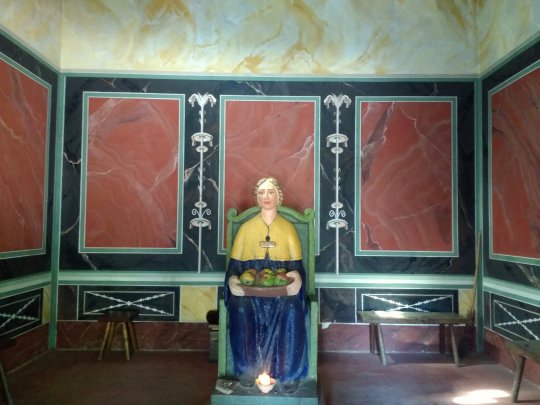



Nehalennia
Nelahennia is a native Dutch Goddess who was mainly worshiped in the modern day province of Zeeland. Several altar stones have been found with depictions of this Goddess and even a temple which has been reconstructed. She wasn't however just worshiped in Zeeland but most likely in Belgica, parts of Britannia and parts of Germania Superior. Altar stones of her have appeared in modern day Cologne and Tongeren as well, showing the spread of this deity's influence by ancient Dutch traders and travelers.
It isn't however fully certain whether Nehalennia has her origins in Celtic or Germanic culture since the area of worship has influences of both cultures. Also the meaning of her name is uncertain but if the name is Celtic in origin, it could mean 'She near the sea', from the Proto-Celtic 'Halen' which means sea. Or if it is Germanic in origin it could mean 'close to the water', or 'she who leads over water', relying on the Proto-Germanic word Nehwa which means 'close'. Both meanings are interesting because they both depict attributes of this deity. It is of course also possible that the name has linquistic influences of both cultures.
So who is she and what does she stand for? Nehalennia is usually depicted sitting on a throne with a basket of fruits next to her and apples on her lap. To the right of her, there is an image of a dog and sometimes she gets depicted holding a cornucopia. She wears a long robe covered with a cloak and a pelerientje, a short cloak once worn by Dutch women. Nehalennia is the only deity in the world who wears a pelerientje, which is a clear clue that she is a regional deity.
Judging by her attributes we can assume that she is the Goddess of both death, the seas and fertility. The dog on her right sight is an ancient symbol of death or the underworld, based on the classic hellhounds which date all the way back to the Proto-Indo European culture. It isn't however 100% certain that the dog refers to death, it could also be a symbol of the north sea which was said to be 'ravaged by dogs' or a symbol of protection.
The basket with fruits and the cornucopia suggests that these are attributes representing fertility. The apple is a very important symbol in several ancient cultures and religions like, Hellenic paganism, Celtic paganism, Germanic paganism and Christian mythology. The apple can refer to wisdom or to an eternal/long life. Some of her altar stones have a ship's rudder on one of the sides or are decorated with sea shells on top, a clear indicator that she has a relationship with the sea and its travelers.
In total, around 160 depictions of her have been found. Unlike other native Dutch Goddessess, of which we only have one or two altar stones, this is a huge amount. The most spectacular find was perhaps the remains of a temple in Colijnsplaat, Zeeland. The temple was based on Roman architecture and has been reconstructed in Colijnsplaat and in the Archeon, Leiden. Rituals are still being held in both these temples in honour of Nehalennia to this very day, I have made my offerings to her in one of these two temples as well.
Some of the altar stones contain inscriptions which further proves our theory that she is a Goddess linked to the sea. Here is one such inscription made to ask for safe passage to Britain:
"To the goddess Nehalennia,
on account of goods duly kept safe,
Marcus Secundinius Silvanus,
trader in pottery with Britain,
fulfilled his vow willingly and deservedly."
Another inscription was made by a salt trader thanking her for what might have been a succesful and safe trade:
"For Nehalennia, Marcus Exingius Agricola,
citizen from Trier, salt merchant in Cologne,
has fulfilled his vow, gladly and with good reason "
It's clear now that travelers and traders who crossed the seas, vowed to Nehalennia for a safe passage across the wild waters of the north sea, confirming the theory that she is a guardian of those who cross seas, which might explain the dog at her right side if it is not a symbol of death.
Since her rediscovery in the 17th century, the Dutch have once more fully embraced this deity again. Even back when Christianity was the most dominant religion of the area, people couldn't help but be utterly fascinated by the discoveries of these altar stones. Nowadays Nehalennia has become a proud symbol of Zeeland and people are worshipping her in her temples once again. There is even a statue of her at the beach of Domburg, facing her dominion, the wild north sea.
Here are images of:
Nehalennia altar stone, photographed by myself at the Rijksmuseum van Oudheden in Leiden, the Netherlands.
The reconstructed temple in Colijnsplaat, the Netherlands.
Artwork depicting Nehalennia, made by Thorskegga.
Interior of her temple at the Archeon, the Netherlands.
Statue of Nehalennia in Domburg, the Netherlands.
75 notes
·
View notes
Photo
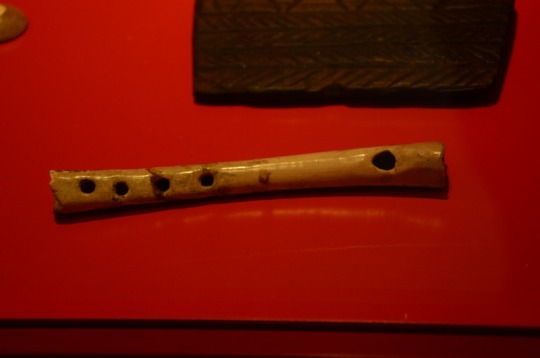
Ezinge Flute
This is a flute carved from a sheep bone which was found in the terp of Ezinge in Groningen, the Netherlands. The Ezinge terp has been inhabited since around 600BC and is a treasure trove for archeologists, as almost all terps are. In total the remains of around 85 farms has been found which date back between 600BC-500AD.
The flute itself dates back between 0-300AD and was most likely used by a Frisii or a Chauci tribe member. I love this image because it shows that the ancient Germanic people enjoyed making music as well. Unfortunately we will never know what kind of tunes they played as there is no written records of their music but it feels good knowing that 2000 years ago, someone was using this flute and creating his/her own tunes.
People still live on the Ezinge terp until this day and the small village has a museum I recommend visiting, once the lockdown ends.
The flute is on display in the Wierdenland museum in Ezinge.
45 notes
·
View notes
Photo

Oera Linda
The Oera Linda is a Frisian manuscript most likely written during the 19th century. The 19th century saw the revival of Germanic paganism but unfortunately this revival was full with political ideologies with overromanticized ideas and images. This book is a product of that era and was later used by the Nazis during the 1930's rise of Nazi occultism.
Nowadays this book is considered to be either a hoax or a 19th century attempt of poety to promote Frisian culture and history. The book appeared around the 1860's and was written in a language that's supposed to look like old Frisian. About ten years later, Jan Gerhardus Ottema translated the Oera Linda into Dutch and published it as a genuine historical source. Already since that published version came out, a debate started on the actual origins of the script and whether it was a genuine ancient text.
So what is exactly written in this manuscript? For starters, the Oera Linda contains an ancient set of runes, these runes are not historical runes but made up by the author. It also contains a history of the family Linden, supposedly this family contains a secret ancient line of pagan priests through which the knowledge of this book survived until the modern era.
There is also the creation story of the Frisii who, according to the Oera Linda, were created by Freya herself and led by a long line of ancestral folk-mothers. There has been an altar stone found however mentioning the ancient mothers so there might be a small core of truth in this theory. Another part describes that the folk-mothers were born from a battle between three human species and the destruction of the ancient land of Altland (clearly a Frisian version of Atlantis). This book follows a similar structure as the biblical book, the Genesis. Perhaps the intention was to give Frisians their own sense of biblical history, to let the world know that the Frisians are as unique and important as the ancient Canaanites.
So who actually wrote this book? It was published anonymously but pastor François HaverSchmidt is theorized to be the actual author of the Oera Linda. Now we can immediately see why the contents of the book are so similar to the biblical stories. Perhaps François wrote the Oera Linda as a parody of the bible, creating his own rune set and faking the old Frisian language in order to fool people. Unfortunately it worked and people were fooled. Until this very day there are people who believe that the contents of this book are actual real historical truths. That is the reason why I wrote this post, to make people aware of the history behind this manuscript to prevent them from falling into that same 19th century romanticized Germanic pagan revival.
Here is a link to the actual manuscript, kudos for the people who can actually translate the fake old Frisian language, http://images.tresoar.nl/OLB/mobile/index.html#p=1
And here is an image of the Oera Linda text containing the fake runes.
40 notes
·
View notes
Photo

Jutes
The Jutes were a Germanic tribe from modern day northern and middle Denmark. Even though they are from the land where the Germanic culture was born, the tribe itself is not as ancient as you would think. It is believed that the Jutes settled themselves in territory that once belonged to the Cimbri. The Jutes were neighboured by the Angles to the south.
The meaning of their name is uncertain as there are several theories about the origin. One theory suggests that the word Jutes is an Anglified version of its ancient name described by Tacitus in 98AD 'Eudoses'. If this theory is correct, the meaning of their name is 'giants'. Eote, the old English word for the Eudoses tribe, is etymologically related to 'eoten', the old English word for the species of giants.
Barely anything at all is known about this tribe except for the fact that large parts migrated towards Britannia during the 5th century. The earliest written mention comes from Tacitus' work Germania which was published in 98AD, if the theory of the Eudoses is correct.
This tribe had settled much later in its territory than the Frisii, Chatti, Batavi or Cherusci per example. A possible theory is that the Cimbri, who lived in the same territory earlier, decided to migrate southwards after the Cimbrian flood, this flood has been described by Strabo, a Greek geographer, but Strabo however has his doubts about the flood:
"As for the Cimbri, some things that are told about them are incorrect and others are extremely improbable. For instance, one could not accept such a reason for their having become a wandering and piratical folk as this that while they were dwelling on a peninsula they were driven out of their habitations by a great flood-tide, for in fact they still hold the country which they held in earlier times and they sent as a present to Augustus the most sacred kettle in their country, with a plea for his friendship and for an amnesty of their earlier offences,
and when their petition was granted they set sail for home; and it is ridiculous to suppose that they departed from their homes because they were incensed on account of a phenomenon that is natural and eternal, occurring twice every day. And the assertion that an excessive flood-tide once occurred looks like a fabrication, for when the ocean is affected in this way it is subject to increases and diminutions, but these are regulated and periodical"
- Strabo
Whatever caused the Cimbri to migrate, it provided an opportunity for the Jutes to settle in their former areas around 0AD. Their new territory, now known as Jutland, was an important part of ancient trade routes dating back to the bronze age. They traded amber, skins and iron with other settlements all around western Europe. After the Roman empire set up permanent borders along the Rhine, the trading activity of the Jutes grew enormously. Now the Jutes also started trading in slaves and leather to both the Roman empire and other Germanic tribes. The Romans especially required a lot of slaves to support their agriculture.
Because of the distance between the Jutes and the Roman empire, they never came into contact with the concept of money. Even if they did, they decided not to adopt this custom and continued using a barter system. There was also less social stratification due to the lack of contact with the Roman empire and their isolated location. This means that there were less differences between social classes, there might have been more equality amongst the Jutes or the boundaries between rich/poor were smaller.
Somewhere during the 5th century AD, the Jutes together with the Angles, Saxons and Frisians, invaded Britannia. The Jutes fought against the Picts and drove the Britons west towards Wales. They settled in Britain together with the other three tribes I mentioned and so the Anglo-Saxons were formed. The few Jutes back in Jutland who did not migrate, were later absorbed into the Danish kingdom.
Here is an image of:
A map showing the location of the Jutes and their invasion of Britannia,
50 notes
·
View notes
Photo

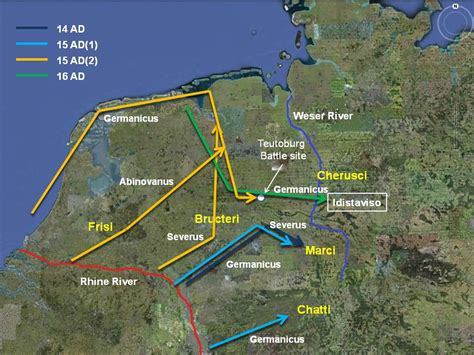
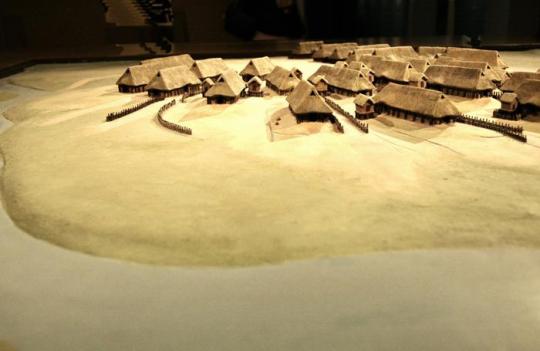

Chauci
The Chauci were a Germanic tribe situated in modern day north-western Germany and parts of north-eastern Netherlands. They were neighboured by the Frisii to the west, the Ampsivarii and Cherusci to the south, and the Lombardi to the east. From a cultural perspective, they were incredibly similar to the Frisii, the reason why is because the landscape was exactly the same, flat swampy coastal land without trees. Both tribes built their homes on terps, artificial hills, to protect them from the sea and both thrived on fishing and raiding.
The meaning of the name Chauci is still a puzzle but there is a theory that the word Chauci is derived from the Proto-Germanic root for the word 'spear', 'ger. Another theory suggests that the word Chauci is derived from the Proto-Germanic word 'Hauhae', high-comers.
The first written mention of this tribe comes from one of Rome's most succesful Roman generals, Drusus Germanicus, yes the same general who died after a fall from his horse. During 12BC, Germanicus was present north of the Rhine and subjugated the Frisii. The Chauci, being their neigbours, were next on Germanicus' list but the Gods were with the Chauci as low tides trapped Germanicus' ships so he was forced to retreat.
The next written mention comes from another Roman general called Germanicus. Between 14-16AD Germanicus invaded Germania in order to revenge the lost battle of Teutoburgerwald. Instead of entering Germania by crossing the Rhine, he sailed around the north sea coast and invaded Germania from Frisii territory. Something quite peculiar happened during Germanicus' campaign between him and the Chauci.
The Chauci did not parttake in Arminius'alliance and were thus not a target of the Roman empire. Yet they weren't popular amongst the Romans either because of their continuous raids on Roman vessels and settlements. I have told the story before on how Germanicus' fleet was hit by a storm and largely destroyed. Germanicus himself however escaped with his life because the Chauci saved him. It is unknown why the Chauci decided to help the Roman army hit by a storm, was it for altruistic purposes or did they just want a better reputation in Rome? The whole event has been described by Tacitus in his annals, here is a small piece:
"But soon the hail poured from a black mass of clouds, and simultaneously the waves, buffeted by conflicting gales from every quarter, began to blot out the view and impede the steering. The soldiers, struck by alarm and unfamiliar with the sea and its hazards, nullified by their obstruction or mistimed help the services of the professional sailors.
Then all heaven, all ocean, passed into the power of the south wind which, drawing its strength from the sodden lands of Germania, the deep rivers, the endless train of clouds with its grimness enhanced by the rigour of the neighbouring north, caught and scattered the vessels to the open ocean or to islands either beetling with crags or perilous from sunken shoals.
These were avoided with time and difficulty but, when the tide began to change and set in the same direction as the wind, it was impossible either to hold anchor or to bale out the inrushing flood. Chargers, pack-horses, baggage, even arms, were jettisoned, in order to lighten the hulls, which were leaking through the sides and overtopped by the waves.
Precisely as the ocean is more tempestuous than the remaining sea, and Germania unequalled in the asperity of its climate, so did that calamity transcend others in extent and novelty, around them lying hostile shores or a tract so vast and profound that it is believed the last and landless deep.
Some of the ships went down, more were stranded on remote islands where, in the absence of human life, the troops died of starvation, except for a few who supported themselves on the dead horses washed up on the same beach. Germanicus' galley put in to the Chaucian coast alone. Throughout all those days and nights, posted on some cliff or projection of the shore, he continued to exclaim that he was guilty of the great disaster and his friends with difficulty prevented him from finding a grave in the same waters.
Not a man returned from the distance without his tale of marvels, furious whirlwinds, unheard-of birds, enigmatic shapes half-human and half-bestial things seen, or things believed in a moment of terror." - Tacitus, Annals
In 47AD both the Chauci and Frisii joined the pirate Gannascus of the Cananefates tribe on his proto-viking raids. The Chauci were notorious for raiding but now with an experienced former Roman soldier at their command, their raids entered a new and destructive phase. The three tribes raided the coasts of Gaul, Britannia and Belgica forcing the Romans to strengthen their defenses and deploy triremes on the Rhine river. Eventually Gannascus was asassinated by the Romans which almost led to a Roman-Germanic war.
Only a few years later in 69AD the Batavi tribe revolted against the Romans together with the Frisii and Cananefates. The Chauci sent military troops to Batavi lands in order to support the revolt. Initially it was a very succesful revolt causing the destruction of two Roman legions and several forts but it was put down the following year by the Romans. Even though the Chauci were willing to save Roman lives from drowning, they continued on raiding and attacking Rome at the same time while also supplying Rome with auxilliary troops.
A few years later, somewhere around 70-80AD, a Roman officer, author and philosopher by the name of Pliny the Elder, visited the lands of the Frisii and Chauci and wrote a description on the landscape and way of life:
"Here a wretched race is found, inhabiting either the more elevated spots of land, or else eminences artificially constructed, and of a height to which they know by experience that the highest tides will never reach. Here they pitch their cabins and when the waves cover the surrounding country far and wide, like so many mariners on board ship are the: when, again, the tide recedes, their condition is that of so many shipwrecked men, and around their cottages they pursue the fishes as they make their escape with the receding tide.
It is not their lot, like the adjoining nations, to keep any flocks for sustenance by their milk, nor even to maintain a warfare with wild beasts, every shrub, even, being banished afar. With the sedge and the rushes of the marsh they make cords, and with these they weave the nets employed in the capture of the fish; they fashion the mud, too, with their hands, and drying it by the help of the winds more than of the sun, cook their food by its aid, and so warm their entrails, frozen as they are by the northern blasts; their only drink, too, is rainwater, which they collect in holes dug at the entrance of their abodes." - Pliny the Elder
Tacitus published his work 'Germania' in 98AD and in his work he also wrote a short description on the Chauci:
"The Chauci are the noblest of the Germanic races, a nation who would maintain their greatness by righteous dealing. Without ambition, without lawless violence, they live peaceful and secluded, never provoking a war or injuring others by rapine and robbery. Indeed, the crowning proof of their valor and their strength is, that they keep up their superiority without harm to others. Yet all have their weapons in readiness, and an army if necessary, with a multitude of men and horses; and even while at peace they have the same renown of valor." - Tacitus, Germania
As you might have noticed, Tacitus' words are not very accurate since the Chauci were known for their piracy so it is unclear why Tacitus described them in such a way.
During the late 2nd century AD, the Chauci intensified their raids once again by destroying and pillaging several settlements across north-western Europe. These raids were so intense that the Roman empire spent the next 30 years on building better defenses. Their trail of destruction is still visible to this day as archeologists have found traces of burned settlements along the north sea coast. The Chauci were true raiders at heart and raiding provided them with supplies and food.
Eventually the Saxon confederation came into existence somewhere during the 3rd century AD. The Chauci were either part of the initial tribes who formed the federation or were absorbed by them later. Over time the Chauci lost their individual identity and became known as the Saxons.
Here are images of:
A map showing the tribe's location
A map showing Germanicus'expeditions (the general who got hit by a storm and was saved by the Chauci),
A reconstruction of a Chauci settlement by Marco Prins,
Unfortunately there is no artwork ,as far as I know, depicting the Chauci on their raids so I chose a picture of raiding vikings instead. That is the downside of vikings being so immensely popular but not the Germanic tribes that preceeded them many centuries before,
48 notes
·
View notes
Photo


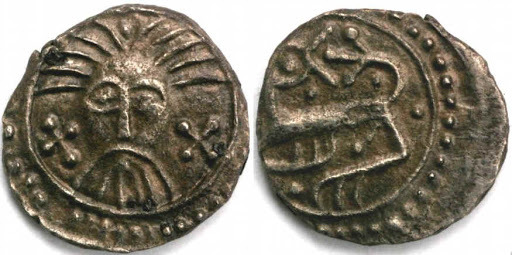
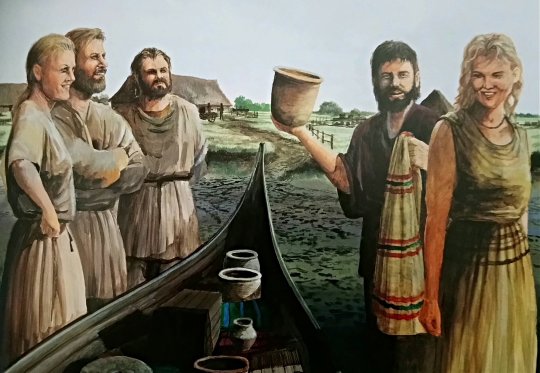

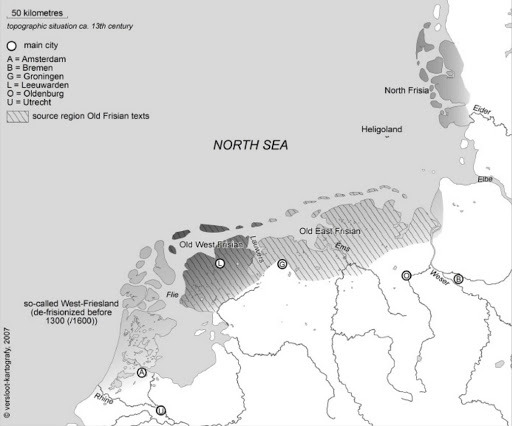
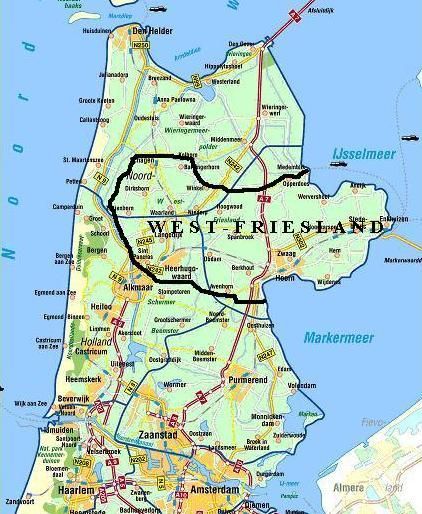


Frisians
We are picking up from where we left off on my post about the Frisii. The Frisians were a germanic tribe/kingdom located in modern day Frisia, Noord-Holland, Zuid-Holland, Zeeland, Utrecht, Groningen, Drenthe and Overijssel in the Netherlands, east-Frisia in Germany and north-Frisia in Denmark. They are the oldest Germanic culture that still exist until this very day with their own unique history, flag, traditions and language.
During the great migrational period, which also marks the end of the iron age and the start of the medieval age, new settlers, mostly Saxons, settled themselves in former Frisii territory. Most of the Frisii had abandoned their homeland and migrated either southwards or to the west to Britannia. Only a very few Frisii remained in their homeland, too little to continue their population.
Around the 5th century AD these migrants were now settled properly and called themselves Frisians. They quickly turned their homeland into a powerful seafaring nation now bordered by the Christianized Franks to the south and the still pagan Saxons to the east, the Frisians were still pagan as well. By 500AD they were possibly the most powerful sea power in western Europe, a power they gained from their long history of sailing and trading.
Since the collapse of the Western Roman empire, the economy in western Europe was in a very sad state. Poverty and hunger were considered to be normal while ancient Roman settlements started to decay and slowly disappear. Between 300-500AD, trade was pretty much dead and time appeared to have stopped moving for the people in western Europe. This all eventually changed thanks to the Frisians who were able to restore trade routes and opened up a path for the now so famous vikings.
During the late 6th century, the Frisians set up wide-spread trading routes all across the north sea, east sea and the Rhine area. In all of these trading areas, settlements grew like cabbage thanks to the wealth that these Frisian traders brought, settlements like: Ipswich in England, Ribe in Denmark and Medemblik in the Netherlands. Already existing settlements such as London and Dorestad grew thanks to this trade. Dorestad, a city which was located in modern day Utrecht, the Netherlands, even became the most important trade hub of western Europe, it was also the capital of the Frisian kingdom.
The Frisians were in fact so dominant in their trade that the term Frisian became a synonym for trader in many Germanic languages until around 1000AD. Curiously enough, many of the trading settlements were not fortified with walls or forts, the 6th and 7th century were relatively peaceful times. It was also the Frisians who reintroduced the concept of money in the form of sceatta coins. The word sceatta itself is Frisian for treasure. Archeologists have found these sceatta coins all around the North sea coast, England, Denmark, Germany and the Netherlands. These sceattas were based on earlier Roman coins. So you can thank the Frisians for the fact that we use money instead of the old trading system.
So what did the Frisians trade exactly? They traded both luxery goods and more mundane goods per example: Fabrics, skins, pottery, metal, cattle, fish, flesh, salt, wine, dairy products, fur, milling stones and even walrus, sea lion and reindeer products which they got from the far North in Scandinavia. They also traded in human lives because the slave trade was a lucrative business and slaves were essential for the early medieval economy.
Who ruled the Frisians? It is not known when the Frisian tribe turned into a kingdom but we do have written sources of some of the earliest Frisian kings. The oldest yet quite unreliable source comes from the epic poem Beowulf which mentions Finn Folcwalding as the first king of the Frisians. It is however doubtful if Finn actually really existed since Beowulf is not exactly a reliable historical source. According to the Poem, Finn was the son of Folcwalding and married a Danish princes, Hildeburh.
Here is a quote from the Beowulf poem:
"The warriors returned then to seek their houses,
bereft of friends, to see Frisia,
their homes and high fort yet Hengest
the death-stained winter spent with Finn,
in a place with no fellowship at all; he remembered his land,
though he could not drive on the sea
the ring-prowed ship: the sea welled in storm,
fought against the wind, the winter locked the waves
in icy bonds, until came another
year to the courtyards, as it still does now,
those which continuously carry out their seasons,
gloriously bright weathers." Beowulf
The first Frisian king of whom's existence we actually got archeological evidence, is king Audulf, who ruled Frisia between 600-630AD. The most famous Frisian ruler however is king Redbad/Radboud who ruled Frisia from 690-719AD. His story is recorded by the Franks, the enemy of the Frisian kingdom. According to these records, Redbad refused to convert to Christianity exclaiming that he would rather spent an eternity in hell with his ancestors than to go to heaven.
It was also under Redbad's rule that the Frisian kingdom reached its peak. The Frisians and Franks were continuously at war with each other as the Franks tried to expand their empire. Not only did the Franks aspire to add more land to their already massive empire, they wanted to convert the Frisians to Christianity as well which they eventually did with quite some violence. Bonifatius and Willibrord were send to Frisia with orders to built churches and convert the local people.
Bonifatius started to chop down sacred trees throughout Frisia, oak trees which were dedicated to Donar, which were used not only for religious purposes but also for judicial purposes. This angered the Frisians greatly and eventually the mob turned against Bonifatius killing him and his followers out of anger and revenge.
Redbad managed to keep Frisia largely pagan until his death in 719AD. After his death, the Frisian kingdom was quickly conquered by the Franks who divided the kingdom into three parts, East-Frisia, Middle Frisia and West-Frisia. One thing I want to mention is that there is a very popular post going around the internet saying that Redbad is the last Frisian king, this is however not true. The last Frisian king was Poppo who ruled Frisia between 719-734AD. It was during Poppo's reign that Frisia was conquered by the Franks, perhaps the reason why most people conveniently leave him out of history.
By the year 734AD, the Frisians were now largely converted to Christianty but some pagans still remained. The latest pagan burial dates back to around 1000AD and some pagan habits like placing offerings in moors and swamps continued on well into the 18th century. It took a very long time before the Frisians accepted Christianity, almost 1000 years before the Christian faith fully got its hold in even the smallest settlements.
Not only Frisia was conquered and converted by the Franks, the Saxons were also invaded by them which led to the Saxon wars which took place between 772-804AD. These wars eventually led to the destruction of the Irminsul and the forcible conversion to Christianity. Countless of pagans were murdered for refusing to convert. The Frisians provided military support for the Saxons in their uprising but it sadly failed. With the arrival of the 9th century, continental Germanic paganism has almost completely died with the exception of Denmark.
The Frisians were no longer independent and by 839AD, the reign of Frisian counts began. During the 9th century, the Frisian territory, now part of Lotharingia, was repeatedly attacked by the vikings. Thanks to the vikings, the Frisians lost their status of the most powerful seafaring nation and an age of terror began. Dorestad, former capital of the Frisian kingdom, was raided several times by the vikings until the city eventually slowly died. It was rediscovered in 1842 during archeological research conducted by L.J.F Janssen, conservator of the rijksmuseum van Oudheden in Leiden.
Since the Christianization of Frisia went so slowly, many of its people still believed in the Germanic Gods by the time the vikings were active. After the passing of Louis the pious, king of the Franks, in 840AD, a power struggle broke out between his three sons which resulted in devastating civil wars. The Frisians, who are genetically and culturally identical to the Danes, decided to stop defending their territories from Danish raiders and so Frisia fell in the hands of Danish rulers. The Frisians and Danes actually had good relationships with each other as their culture and religion were the same. It is believed that many Frisians turned viking as well and joined the Danes in their viking raids.
Eventually the viking raids stopped but the Frisians, now known as the West-Frisians, continued their good relationships with Denmark, a friendship which continued for many centuries as Holland and Denmark later united to battle the Swedes, in fact this friendship still endures until this very day and was recently celebrated between both governments.
The counts of West-Frisia, who governed on behalf of the Holy Roman Emperor, ruled over the area which was formally part of the Frisian kingdom, modern day Noord-Holland, Zuid-Holland, Friesland, Groningen, Drenthe, Utrecht and east-Frisia. The first known count is Dirk I who governed over Frisia between 916-928AD. This line of counts continued until count Dirk V of West-Frisia declared himself as count of Holland and so the province of Holland was born.
The climate of Europe changed again between 800-1200AD, the medieval warm period had begun. This eventually led to a gigantic flood, the Sint-Lucia flood, which created the Zuiderzee and separated West-Frisia from East-Frisia. Eventually east-Frisia became known as simply Frisia but West-Frisia, now reduced to an area connected to Holland, continued to exist under its former name. The remaining part of West-Frisia refused to join Holland which resulted in the West-Frisian wars which lasted around 160 years.
West-Frisia was eventually absorbed into Holland by count Floris V during the late 13th century after series of battles and a mass slaughter committed by the Hollanders on West-Frisian men, women and children. Even though West-Frisia is nowadays part of Holland, they still remain their own unique identity, anthem, flag and dialect. the province of Holland grew into the most powerful province of the low lands and eventually revolted against their Spanish overlords in 1568, a struggle now known as the 80 years war for Dutch independence which resulted in the free republic of the united provinces in 1648, the creation of the Netherlands as a united land.
Meanwhile east-Frisia, now known as Frisia, continued to resist against every power that tried to conquer the territory. Frisia became an independent territory around the year 1000AD and continued to be independent until they decided to join the Dutch revolt against the Spanish. Frisia joined the union of Utrecht and became part of the Dutch republic and still continues to be part of the Netherlands until this very day although some Frisians want to reclaim their independence again.
I am sorry for this long post on the history of the Frisians but they have a very long history that deserves to be told since they greatly influenced all of Europe and are the oldest still existing Germanic culture of Europe.
Here are images of:
a map showing Magna Frisia, the Frisian kingdom at its peak.
An image of king Redbad/Radboud,
Frisian traders, artist unknown,
A map of the Frisian trade network,
Frisian sceatta coins with a depiction of Wodan,
a map showing West-Frisia before the formation of Holland,
A photo that I took myself of West-Frisian remains badly maimed by soldiers of Holland during the West-Frisian wars,
Current territory of West-Frisia,
map showing present day Frisia and east-Frisia
96 notes
·
View notes
Photo
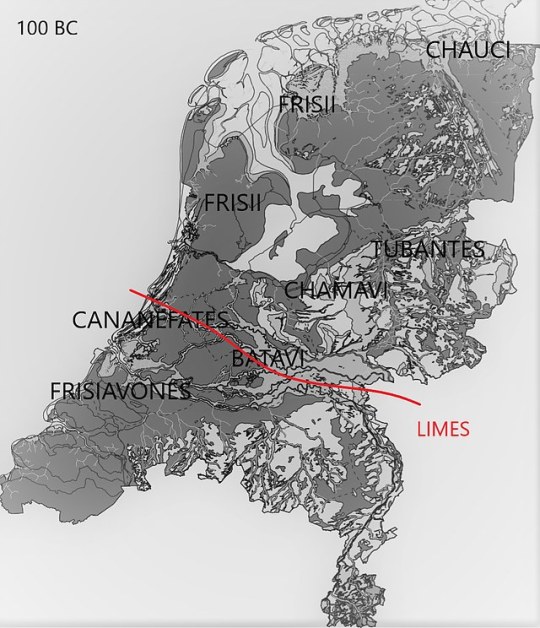
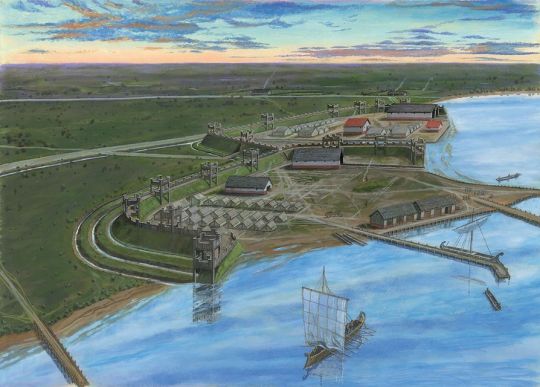


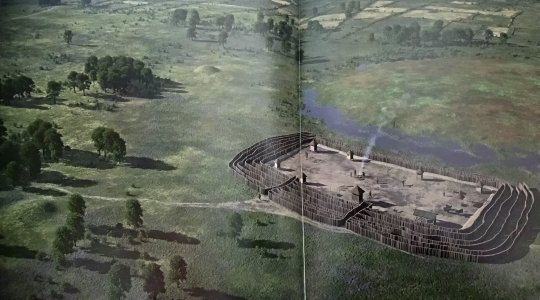

Frisii
This is a rewritten post on the Frisii tribe, my previous post is over a year old so I wanted to update it by adding more information.
The Frisii were a Germanic tribe who lived above the Rhine in areas that are now known as modern day Noord-Holland, Friesland, Groningen, the Wadden islands in the Netherlands and East-Frisia in Germany. They should not be confused with the Frisians, a tribe which settled in the same area at a later time period, The Frisians and Frisii are however not completely foreign to each other, some Frisii stayed behind and were absorbed by the Frisians, the oldest still existing Germanic culture. The Frisii were neighboured by the Cananefates to the south and Chauci to the east, the west and north were part of the north sea.
The meaning of their name is derived from the Proto-Germanic word 'frisaz' which means 'curly'. There is a common misunderstanding that the word Frisii, and the later Frisian, comes from the word freeze/vriezen or freedom but this is not correct although understandably a good possible meaning.
The origins of the Frisii is still a bit unclear but there are viable theories. Unlike other tribes, like the Chatti, Lombards, Batavi, Cananefates etc.. who all migrated southwards and settled in their territories around 100BC, the Frisii are a lot older. In fact we do not know how old exactly they are but there are several theories:
The most likely theory is that the early Frisii, also called Proto-Frisians, migrated southwards from northern Germany and Denmark around 1000BC. Somewhere around 700BC they migrated from modern day Drenthe towards modern day Friesland, Groningen and Noord-Holland. There is however a more controversial theory that suggests the birth of the Frisii started with their patron-mother the Goddess Freya.
According to this theory a line of matriarchal rulers, known as folk mothers, were descendants of Freya herself and responsible for the creation of the Frisii, this would mean that the origin of the tribe is not around 700BC but around 2200BC. Here is a line of Frisii folk mothers starting with the Goddess Freya:
Freya - somewhere around 2000BC
Fasta, Medea, Thiania, Hellenia, Minna, Rosamond, Hellicht, Frana, Adela and Gosa. Of course if there was a continuous matriarchal line for about 1500 years long, this would include many more names but those are lost in time.
This theory is based on the information found in the Oera Linda book, a highly disputed manuscript worthy of its own post so I will write about it in the near future. An altar stone has been found near modern day Xanten however with the following description: "MATRIBUS FRISAVIS PATERNIS" which could refer to these ancient Frisii matriarchs making the Oera Linda book theory possible.
By 100BC the Frisii were quite a large and powerful tribe who had established themselves fully in their current territory. Their first encounter with the Roman empire was around 12BC when Drusus Germanicus, one of Rome's most succesful generals, invaded Germania with the intention to turn the land into a province of Rome.
Drusus Germanicus, not to be confused with the other Roman general called Germanicus, was incredibly succesful with his invasion. He subjugated every Germanic tribe in his path including the Frisii who were forced to be allies of Rome. The Romans also built a fort, their most northern one, at modern day Velsen to keep an eye on the Frisii. It is likely that all of Germania would have become a Roman province if Germanicus didn't die after a fall from his horse in 9BC.
The Frisii delivered auxiliary troops to Rome and they had to pay taxes which led to high tensions between the tribe and Rome. The taxes were incredibly unfair as the Romans demanded large skins of cows which did not even exist in Frisii territory, they only had a small breed of cows. This rising tension eventually led to the Frisii revolting against Rome in 28AD. The Frisii hung Roman tax collectors which infuriated Rome.
Olennius, a Roman centurion in charge of Frisii administration, escaped the lynching party and hid himself at Castellum Flevum, the most northern fort the Romans ever built. The Frisii however marched onwards to this fort but were unable to capture it, archeological research shows traces of heavy fighting at this fort. The Frisii retreated back towards their sacred grove dedicated to their Goddess of war, Baduhenna, luring the Romans with them.
The Romans chased the Frisii right into the sacred grove. This was however a dreadful decision since the Frisii knew their swampy estuary terrain very well and were extra motivated by being in the presence of their battle Goddess. Almost all of the Romans were slaughtered, 900 of them, some according to legends, were captured and sacrificed to Baduhenna right in her grove. Another 400 Roman soldiers killed each other out fear of treachery, the event has been quoted by Tacitus:
"Soon afterwards it was ascertained from deserters that nine hundred Romans had been cut to pieces in a wood called Baduhenna, after prolonging the fight to the next day, and that another body of four hundred, which had taken possession of the house of one Cruptorix, once a soldier in our pay, fearing betrayal, had perished by mutual slaughter." - Tacitus
The Frisii name thus became famous in Germania and Roman emperor Tiberius tried to keep the Roman defeat a secret, not wishing to entrust anyone with the war because of the shame. The Roman fort in modern day Noord-Holland was abandoned after the revolt and the Frisii became free people once again and remained so until the medieval ages.
The earliest known written record that we have about the Frisii comes from a Roman poet Albinovanus Pedo. In one of his poems, he describes a disaster that occured during Germanicus' campaigns to avenge the Teutoburgerwald battle. This disaster took place around the Eems river in Frisii territory around 16AD and involves a storm destroying parts of his fleet:
"For a long time they had left the day and the sunlight behind them, for a long time they looked exiles from the well known part of the world, who had dared to go through forbidden darkness to the boundaries of nature and the furthest coast of the earth.
From here they saw him, the sea, carrying huge monsters under slow waves with rising wild whales and the dogs of the sea on all sides grabbing ships. The fleet was already in the mud, left behind by a rapid storm. They believed that their unfortunate fate was to be torn apart by these wild sea monsters.
The world was robbed, nothing could be distinguished, his breath was taken from him, and thus he spoke from his heart:
Where do we end up? The day itself is fleeing and nature closes the rest of the world with eternal darkness. Do we sometimes look for people untouched by wars? The gods call us back, forbid that mortal eyes see the end of everything. Why do we violate a strange and consecrated sea with oars? Why do we disturb the silent dwellings of the gods?"
- Albinovadus Pedo
The next written mention is quite an interesting one. It involves a dispute about land on the Roman border area. Two Frisii leaders, Verritus and Malorix decided to travel to Rome in 58AD and defend their case about this piece of land. During their stay in Rome, they amused the Romans greatly by refusing to sit down amongst the common people in a theater exclaiming that: "No people can match the Germanics in loyalty and bravery!" They then proceeded sitting down next to the Roman senators present in the theater. The Roman emperor, Nero, found the whole event quite amusing himself and granted Verritus and Malorix roman citizenship.
This account, described by Tacitus, is also the first account of foreign tourists visiting Rome who were mentioned by name.
In 69AD, during a particulary tough year for the Romans, the Batavi revolted against the Roman empire. The Frisii joined this revolt which was initially quite succesful. Unfortunately the revolt was put down by the Romans the following year, resulting in severe trust issues between the Romans and the Batavi and Cananefates.
By 98AD Tacitus published his work 'Germania' and also provices us with a small description on the Frisii. He separated the tribe in two parts, the Frisii Maiores and the Frisii Minores. The Minores lived in what is now Noord-Holland and the Maiores lived in what is now Frisia and Groningen. Here is a description on the Frisii landscape:
"The terrain is fierce, the climate is rough, life and landscape are bleak. You only come here if it's your homeland." - Tacitus
No significant recorded events exist after 98AD, the history on the Frisii between 100AD-300AD is pretty much unknown. We do know that parts of the Frisii joined the Cananefaat pirate/proto-viking Gannascus in his raids on several settlements, mainly in Gaul. These attacks infuriated Rome and led to improved defenses being built by them. Gannascus is eventually assassinated by the Romans under the pretence of a negotiation which caused great outrage amongst the Chauci, Frisii and Cananefates. The Roman emperor of that time, Claudius, feared a violent conflict with these tribes and withdrew Roman forces from the Rhine in order to ease tensions.
Around 300AD the Saxon confederation came into existence and bordered the Frisii directly to the east. The Western Roman empire started to decline rapidly during this time period as well leaving the borders vulnerable for invasions. With the Huns invading Europe, economic hardship, climate change, failed harvests and empty Roman borders, came the great migration. Many Frisii migrated either southwards to become absorbed by the Franks or to the west by invading Britannia together with the Angles, Saxons and Jutes. Only very few Frisii remained in their original homeland, we have archeological evidence that some did indeed stay.
Frisii lands were now almost completely deserted until the arrival of Saxons and Jutes who settled the area together with the few remaining Frisii. These new settlers started to call themselves Frisians, after the ancient Frisii. The Frisians still exist until this day and they have a rich history which deserves a post of its own, which will be coming very soon.
The last thing I want to mention is the auxiliary troops that the Frisii supplied Rome with. The Notitia Dignitatum, a Roman document that describes details of the administrative organisation of the empire, mentions a Frisii cohort stationed at Vindobala, a fort located at Hadrian's wall. This entry 'Tribunes cohortis primae Frixagorum Vindobala' however contains a possible spelling mistake, Frixagorum instead of Frisiavonum. This entry might however also refer to the Frisiavones tribe unrelated to the Frisii.
Here are images of:
A map showing the location of the Frisii,
A reconstruction of Castellum Flevum,
A depiction of the Frisii fighting Romans by an unknown artist,
A reconstruction of a Frisii fortification,
A small piece of a Roman helmet, bottom left, found at Velsen where once the Castellum Flevum stood which was attacked by the Frisii,
A depiction of the Goddess Freyja, the ancestral mother of the Frisii, from 1874,
85 notes
·
View notes
Photo


Harii
I have written about them a year earlier but I have rewritten this post to include more information about them.
The Harii were a Germanic tribe shrouded in mystery. Little is known about the origins of this tribe and its exact location. Some historians claim that the Harii came from modern day northern Germany but others suggest that they came from the south, modern day southern Germany and Poland, if Tacitus is correct this would be a more likely location of them.
There is of course also the possibility that the Harii were not even a tribe at all. Perhaps it is just a name for the legendary warriors who belonged to it. The name Harii is Germanic and is derived from the word 'ger' which means 'spear. The name is in plural so you could translate it into 'spears' or perhaps 'army'.
We only know of their existence thanks to a description made by Tacitus in his work the Germania:
"The Harii, fierce beyond the superiority of strength they possess over the other just enumerated people, improve their natural ferocity of aspect by artificial helps. Their shields are black, their bodies painted, they choose the darkest nights for an attack and strike terror by the funereal gloom of their sable bands, no enemy being able to sustain their singular, and, as it were, infernal appearance since in every combat the eyes are the first part subdued."
- Tacitus, Germania
Tacitus describes here a ghostly army of painted men who attack in the night. Some historians compare these warriors to the Einherjar and others theorize that these warriors were the inspiration for the dead in Wodan's wild hunt. Their blackened appearance might have actually been inspired by legends of the wild hunt. It is possible they tried to emulate the hunt in order to terrorize their enemies, which apparently, according to Tacitus, was a very succesful tactic.
One thing I do really want to mention is the theory that the Harii were perhaps not even Germanic at all. If you read the Germania more closely, the Harii seem to have been part of the Lugii community:
"for a continued ridge of mountains separates Suebi from various remoter tribes. Of these, the Lugii is the most extensive, and diffuses its name through several communities. It will be sufficient to name the most powerful of them: the Harii, Helvecones, Manimi, Elysii, and Naharvali." - Tacitus, Germania
The Lugii were not a tribe but a confederation of tribes of Celtic origins. Although it is uncertain if all tribes belonging to this confederation were fully Celtic, it seems some Germanic tribes like the Semnones and the Lombards were part of it as well. Also according to Strabo's work Geographica, the Lugii were subjected to the rule of Maroboduus, ruler of the Marcomanni tribe, which was a Germanic tribe.
It appears that the truth lies somewhere in between. It is very well possible that the Harii were actually Celtic in origin, that would explain the painted bodies since that is not a Germanic but a Celtic tradition. They might have been greatly influenced by the Germanic culture and perhaps adopted it as their own.
What is also a bit mysterious is the fact that the Harii were never mentioned again after 98AD. Were they perhaps fully absorbed into the Lugii confederation and were thus known as the Lugii instead of the Harii? There is also of course the small possibility that the Harii migrated to an unknown location.
If the Harii were Celtic in origin, judging by their probable location, they might have once belonged to the Hallstatt culture and their origins could predate the Germanic culture itself. The Hallstat culture is the first Celtic, Proto-Celtic, culture in existence, dating back to around 1200-800BC.
The question that remains however, did these legendary warriors really exist? If they were Celtic in origin, it is very well possible that they would have used woad in order to intimidate their enemies. Combine Germanic guerilla tactics with nightly raids and painted warriors screaming to the Gods as they attack, I bet anyone who faced them would have been absolutely terrified.
You might have recognized the image of the Harii in the band Heilung. During their live performances they use volunteers dressed up as Harii warriors.
Here are images of:
Harii warriors depicted by Sammi McEwan for the Total war games,
Depiction of Harii warriors in the band Heilung, photographed by Lykke Nielsen,
77 notes
·
View notes
Photo
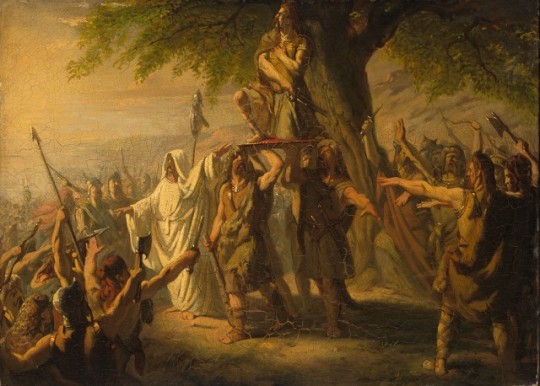


Cananefates
It has been over a year since I have written a post on the Cananefates tribe. I have rewritten the post to include more information since it was quite a short post. This tribe is personally one of my favourites because I currently live in former Cananefates territory and so have my ancestors for about a 1000 years, at least as far as my family tree goes back.
The Cananefates were a Germanic tribe located in modern day Zuid-Holland, the Netherlands in the Rhine delta. Their neighbours to the east were the Batavi, to the south the Frisiavones and to the north the Frisii. They obviously had no neighbours to the west because they lived on the coasts of the north sea.
The name of this tribe is a bit strange and the origins of the Cananefates people is also not fully clear. There are two possible theories: one theory suggests that the Cananefates are actually a small splinter group of the Batavi, the other theory suggests that both the Batavi and Cananefates broke off the Chatti after an internal conflict. The only thing that is sure is that the Batavi and Cananefates were related to each other. Another completely different theory suggests that the Cananefates were perhaps Celtic in origin but adopted the Germanic culture or the other way around.
Several reasons to support the last theory is the name of the tribe. The word Cananefates means 'master of leeks', the first half of the name is Celtic and the latter Germanic. The meaning is quite curious because it isn't really that much of a heroic name compared to most other Germanic tribes. It does however suggest that they were very skilled at farming.
The first Roman who recorded the existence of this tribe was Julius Caesar in his work 'De Bello Gallico'. He describes how the Batavi and Cananefates live on an island in the Rhine delta. Another Roman who gave a more detailed description of the Cananefates was Tacitus. He described the Cananefates as a tribe smaller than the Batavi but they equalled the Batavi in their skills of war. Just like the Batavi, the Cananefates supplied the Roman army with auxiliary units and some even served as imperial bodyguards.
Despite being only a small tribe, the Cananefates have accomplished fairly great things, one example is the story of Gannascus, the Cananefaat who terrorized coastal settlements with raids, he's considered to be one of the earliest proto-vikings. I have written a seperate article about his life for those who are interested. Another unknown Cananefates auxiliary officer was present at Caligula's infamous attack on the sea. An event that the Cananefates would never forget.
The most famous Cananefaat was Brinno, a chief of the tribe. The Cananefates and Batavi were not only related to each other but they were close allies as well. When the Batavi revolted in 69AD, Brinno called upon his tribe to join the revolt against the Romans. Tacitus has described Brinno in his work 'the annals' as following:
"Among the Cananefates was a foolish desperado called Brinno. He came from a very distinguished family. His father had taken part in many marauding exploits. The mere fact that his son was the heir of a rebel family secured him votes. He was placed upon a shield in the tribal fashion and carried on the swaying shoulders of his bearers to symbolize his election as leader.
Immediately calling upon the Frisians, a tribe beyond the Rhine, he swooped down on two Roman auxiliary units in the nearby quarters and simultaneously overran them from the North Sea. The garrison had not expected the attack, nor indeed would it have been strong enough to hold out if it had. So the posts were captured and sacked."
- Tacitus, the annals
If you want to know more about Brinno, I have written a post about him as well.
Besides all their military accomplishments, their most unique trait was farming. The tribe's name rightfully means 'master of leeks' because the Cananefates had the most ingenious farming system of all the Germanic people and perhaps of all Western Europe. In Vlaardingen, Netherlands, certain valves were found dating back to 100AD. These valves were used to direct water to a specific direction. They built dams and used these valves to direct water away from the crops during high tides and heavy rains. This is the oldest sluice system of Western Europe.
The Cananefates were perhaps also the Germanic tribe with the most Roman influences. When the Romans encountered this tribe, the Cananefates were still living in tiny hamlets consisting of a few farms. By 130AD the Cananefates had a capital city, Forum Hadriani, with a typical Roman layout and streets made of brick. Their temples looked exactly the same as classic Roman temples, although they were smaller.
Unfortunately nothing much more is known about this tribe after 170AD. We know that the Cananefates continued raiding coastal settlements to the great annoyance of the Romans. Together with the Chauci and Frisii, they truly terrorized towns across Gaul and Britannia causing the Romans to drastically improve their defences.
Eventually the Cananefates were absorbed by the Franks around 350AD, it is also very much so possible that the Cananefates were one of the tribes who were responsible for the formation of the Frankish confederation.
The Cananefates supplied Rome with soldiers, some records of these soldiers and their units have survived. We know per example that the Cananefates and Batavi always had a combined force of about 5000-6500 men serving in the Roman army and that the Cananefates supplied Rome with 24 new recruits each year, the Batavi 240 new recruits. We also know that there was one Cananefates auxiliary cavalry unit and that this unit was also involved in the Frisii uprising. They suffered heavy losses at the battle of Baduhenna grove.
Initially the Cananefates auxiliary were deployed close to their homelands, such as during the Frisii revolt. But the Romans lost their trust in the Cananefates after the Batavi revolt so after 69AD, the Cananefates were deployed far away from their homeland in modern day countries like Romania, Hungary and Algeria.
Another interesting little fact is that the Roman influence did not only extent into Cananefates architecture, religion and military. Quite some family members of Cananefates, and also Batavi, auxiliary troops were literate. Even in the lower classes, many women, whose husbands were serving in the Roman army, were able to write so that they could communicate with them.
Here are images of:
A map showing the location of the Cananefates,
Brinno being carried on a shield, art by Jacob de Vos,
Remains of the Cananefates capital in modern day Voorburg,
55 notes
·
View notes